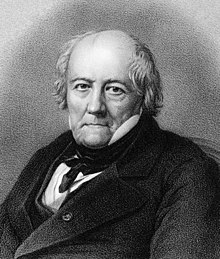Jean-Baptiste Biot | |
|---|---|
 Jean-Baptiste Biot | |
| Born | 21 April 1774 Paris, France |
| Died | 3 February 1862 (aged 87) Paris, France |
| Nationality | French |
| Alma mater | École Polytechnique |
| Known for | Biot number Biot–Savart law Circular dichroism Optical rotation |
| Awards | Pour le Mérite (1850) Rumford Medal (1840) ForMemRS (1815) |
| Scientific career | |
| Fields | Physics, astronomy and mathematics |
| Academic advisors | Gaspard Monge[1] |
| Signature | |
 | |
Jean-Baptiste Biot (/ˈbiːoʊ, ˈbjoʊ/;[2] French: [bjo]; 21 April 1774 – 3 February 1862) was a French physicist, astronomer, and mathematician who co-discovered the Biot–Savart law of magnetostatics with Félix Savart, established the reality of meteorites, made an early balloon flight, and studied the polarization of light.
The biot (a CGS unit of electrical current), the mineral biotite, and Cape Biot in eastern Greenland were named in his honour.